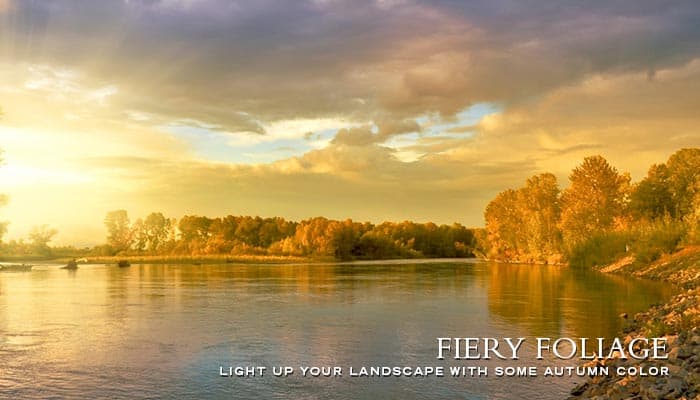Autumn is upon us, and here on the East End we get to enjoy some of the finest weather of the year, with cloudless blue skies above a landscape suffused in mellow golden light. Other days are gray, dramatically blustery and cloudswept. The latest flowers are still blooming in gardens, and the last roses of summer are still with us. Out in the landscape, trees and shrubs can bring warm, bright autumnal colors to your property. The brilliant oranges, golden yellows, vibrant reds and deep purples of fall glow in the soft, slanting light of a clear afternoon, and they positively blaze against a slate-gray cloudy sky. Here are some trees and shrubs to consider adding to your landscape to light up the scene with some autumn fire.
Japanese maples, whose graceful forms and lobed, notched or serrated leaves are elegant in the landscape all year, turn bright shades of red, scarlet, orange or yellow in fall. The foliage of witch hazels, which bloom very early, as winter begins to ease its grip, glows sunny yellow in autumn. Burning bush euonymus lives up to its name, its autumn leaves fiery scarlet (but grow this one with care; it can become invasive, so pull up unwanted seedlings if you spot any.) The paperbark maple, whose shaggy, peeling bark adds appealing textural interest to smaller gardens and landscapes, sports deep orange leaves in fall. River birch, also loved for its attractive peeling bark, turns its foliage yellow this time of year. The leaves of flowering dogwoods turn shades of red to orange, sometimes with purple tones, too, and shrub-type dogwoods go yellow. Viburnums, whose white flower clusters are so decorative (and wonderfully fragrant in the case of Koreanspice viburnum) in spring and summer, reward us again in autumn with red-purple to orangey red leaves.
Some of the native trees and shrubs so admirably suited to our growing conditions also display autumn colors. The tough and adaptable shadblow, or serviceberry, tree can be spotted in spring in gardens and in the wild with its white flowers, and in fall its leaves glow rich yellow to orange. Sassafras is another wildling; this one pops up where it will (and can be a pest), but in fall its mitten-shaped leaves turn bright yellow, orange or red, or even a combination. Black tupelo also decks itself in shades of red, orange, yellow or even purple. For a rich red blaze, look to eastern red maple.
Trees aren’t the only source of bright fall foliage. Our native sweet pepperbush, or summersweet, is a shrub that presents wands of lightly fragrant white flowers in summer and richly golden foliage in fall. Oakleaf hydrangea turns deep shades of bronze and burgundy (and deserves to be more widely grown for its neat habit, lobed leaves and cone-shaped heads of creamy white flowers). Sumacs aren’t for the neat-and-tidy landscape—they form wild and weedy-looking colonies and need room to spread out. But in fall light they’re a blaze of brilliant orange and red in informal landscapes where conditions don’t lend themselves to more demure plants.
Adding some of these trees and shrubs to your landscape can provide a decorative backdrop for late-season barbecues or soaks in the hot tub. And you’ll enjoy an extension of outdoor color long after summer’s gone.








